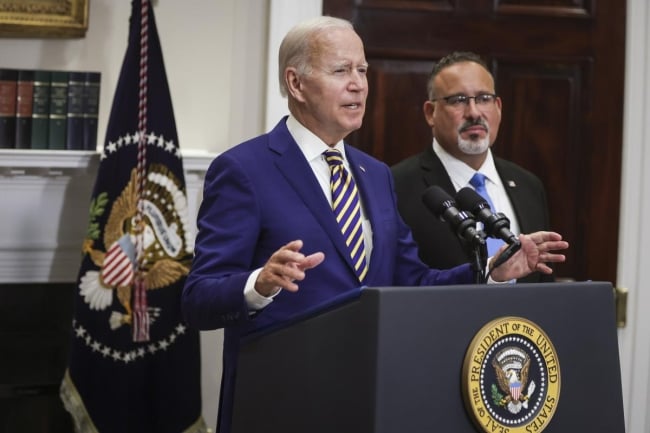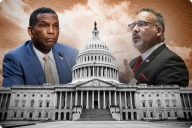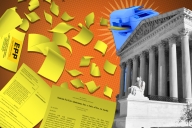You have /5 articles left.
Sign up for a free account or log in.

President Biden announced changes to income-driven repayment plans, which lower monthly payments for low-income borrowers.
Alex Wong/Staff/Getty Images
As the dust settles on President Biden’s first attempt to cancel student debt, the Education Department is moving forward on a plan to overhaul how students pay for college.
Under the plan, millions of borrowers could have no monthly payments on their loans when the three-year payment pause ends in 10 weeks. Experts say that change would disproportionately benefit borrowers with the lowest incomes.
“If you make less than $15 an hour, you’ll have a $0 payment on your loans, and that’s just really game changing for a lot of people,” said Sarah Sattelmeyer, project director for education, opportunity and mobility in the higher education initiative at New America, a think tank.
The Biden administration is looking to create a new income-driven repayment option known as the Saving on a Valuable Education (SAVE) plan. The plan has been in the works for more than a year and was finalized last month. Biden announced the initial parameters for the proposal alongside his plan for student loan forgiveness back in August.
The program—which Biden administration officials said is not a substitute for debt relief—is aimed at providing a safety net for borrowers, making student loan payments more affordable and offering more pathways to forgiveness. Undergraduate borrowers would see their payments cut in half starting next summer, while those who borrow $12,000 or less would be eligible for forgiveness after making payments for a decade, among other changes. (Current plans offer forgiveness after 20 or 25 years of payments.)
While those changes will take effect on July 1, 2024, others, such as exempting more of a borrower’s income from the calculation used to determine payment amounts and waiving unpaid interest, will begin at the end of this month. Income-driven repayment plans calculate payments based on a borrower’s discretionary income and family size.
The SAVE program was one prong of a three-part plan announced in the wake of the Supreme Court’s 6-to-3 decision to strike down Biden’s plan to forgive up to $20,000 in student loans for eligible Americans. Congressional Republicans called the SAVE plan “deeply unfair” and a sucker punch to taxpayers. Other groups, including one that challenged the debt-relief plan, said they were exploring their legal options to challenge this plan in court.
Biden administration officials said last month the legal authority for the new IDR plan under the Higher Education Act of 1965 is “crystal clear.”
“I’d be surprised if there was a legal challenge to that proposal,” said Bharat Ramamurti, deputy director for the National Economic Council, at a White House press conference last month.
The House Republicans’ budget for the Education Department, released Thursday, would block the agency from moving forward with its plans to overhaul income-driven repayment.
‘All Hands On Deck’
Sattelmeyer said the next few months will be an “all-hands-on-deck moment” to ensure borrowers can access the relief they are eligible for. Historically, borrowers who need the relief the most don’t know about it and have found the repayment options difficult to access. Sattelmeyer’s team at New America found that when those borrowers are told about IDR and their options, they are more likely to sign up.
“The hurdle is just making sure people know about and have access to enrolling in these plans,” she said.
The department said the application for the SAVE plan will be available later this summer. Student loans will begin accruing interest Sept. 1, and the first bills will be due in October.
Debt-relief advocates and consumer advocacy groups are concerned that, with student loan payments starting in 10 weeks, the plan could sow more confusion for borrowers.
“If advocates who have been working on this issue for years need a week to understand these programs, how are borrowers ever going to understand it?” said Cody Hounanian, executive director of the Student Debt Crisis Center.
Hounanian said that for borrowers who are juggling other responsibilities, understanding their options and thinking about the best path forward is “an insurmountable task” right now.
Hounanian and other advocates said the new repayment plan is not enough without debt cancellation. The Biden administration is still working on a path for mass debt relief.
“This SAVE plan would have been music to our ears a decade ago or even five years ago,” said Natalia Abrams, founder of the Student Debt Crisis Center, adding that the movement for student loan reform has moved beyond that.
Abrams said the center is looking to “untangle this confusion” about the SAVE plan, the administration’s other plans regarding the payment restart and the consequences for borrowers before hosting repayment workshops.
‘A Crucial Lifeline’
Brian Denten, an officer for the Pew Charitable Trusts’ student borrower success project, said income-driven repayment is “a crucial lifeline” for borrowers and “an essential piece of the puzzle” as payments resume.
“These are really long-lasting changes that will be in effect for years to come,” he said. “For current borrowers and future generations of borrowers, I think it’s really important to get these rules right and get them implemented quickly because I think they really do stand to help a lot of folks if they are administered well.”
About 30 percent of borrowers are currently enrolled in an IDR plan. Several analysts expect that number to at least double because of the administration’s changes.
The final version of the plan is largely unchanged from the department’s first proposal released earlier this year, which critics said was costly and exceeded the agency’s authority.
Low-income borrowers won’t have to make any monthly payments if they earn less than 225 percent of the federal poverty level. That’s $32,500 a year for a single borrower.
“The effect of that is going to be a lot more borrowers making $0 payments,” Denten said. “We think raising that floor in particular is a really important part for those borrowers who struggle the most.”
Borrowers also won’t see their balances grow because of interest under the new plan if they make payments on time. Denten expects that change to help borrowers stay on track with repayment, based on Pew research.
‘A Big Risk’
Experts say the overhaul of income-driven repayment could reshape how students pay for higher education, especially if more people take advantage of the more generous plan. The department said the plan would cost $156 billion over 10 years. The Congressional Budget Office put the price tag closer to $276 billion without cancellation and estimated that borrowing would increase as well.
Jason Delisle, a nonresident senior fellow in the Center on Education Data and Policy at the Urban Institute, said individuals with bachelor’s degrees who enter public service occupations, like teaching, nursing and law enforcement, will likely reap the largest benefits from the plan. They’ll pay less over a decade and then see their loans discharged under the Public Service Loan Forgiveness program. Meanwhile, he said students in certificate and associate degree programs will have new incentives to take out loans.
“If you don’t borrow, you’re probably leaving money on the table for those with lower earnings and shorter-term credentials,” he said.
If the IDR plan does lead to more loan forgiveness, Delisle said that could give higher education critics more ammunition to say the loans paid for programs not worth the investment.
Thus, the changes are a “big risk” for the overall higher education system as well as the federal student loan program, particularly as conservative support for the federal student loan program has eroded.
“It’s going to be interesting to watch, now that the mass loan-forgiveness case is over, if people now start to understand the ramifications of this and just how big it is,” he said.
Delisle said that a few of the department’s changes, such as the interest waiver and providing forgiveness sooner for borrowers with low balances, make the program function better. He’s skeptical about the other changes that are aimed at lowering monthly payments.
“Just lowering payments just to lower payments was one that I think is far more debatable as to what objective that’s really achieving,” he said.
He’s also concerned about the department’s ability to run an income-driven repayment program. In the past, the department failed to track payments and faced criticism for not doing enough to ensure eligible borrowers receive forgiveness through the program.
The Office of Federal Student Aid, which oversees the student loan system, is facing budget cuts after Congress left the agency’s budget flat for the current fiscal year.
“I don’t think we can give them the benefit of the doubt,” he said. “I think that’s the real concern. You’re dangling these big benefits in this new IDR plan, but we don’t really know how smoothly they’re going to implement it.”








